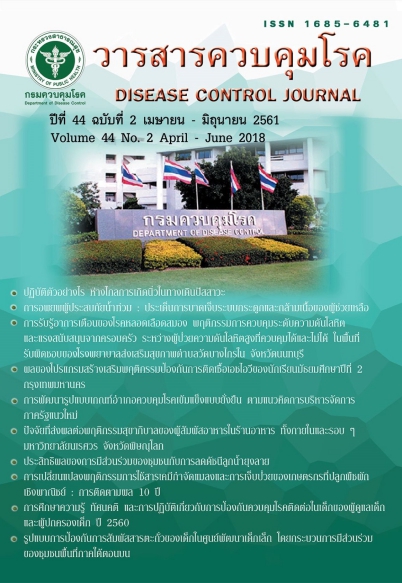Preventative model for lead exposure in children at child development centres based on community participation in the upper southern Thailand.
DOI:
https://doi.org/10.14456/dcj.2018.20Keywords:
community participatory, lead in the environment, child development centre, prevention of childhood lead poisoningAbstract
This research was a participation action research. The aimed of this research was to study environmental lead and develop a model to prevent lead exposure in children at child development centres by community participation in 7 provinces in the upper southern areas. The purposive sampling was used to collect data from 2 centres of each province all together 14 centres govern by local administrative organizations and municipalities. Descriptive statistic was applied for the analysis. The amount of lead in the environment of child development centres was conducted by wipe method. Questionnaire was used to receive general data, environment and teacher activities to reduce lead exposure in children at child development centres. The formulation of a preventative model for lead exposure in children at child development centres was obtained by community stakeholder participation process, once at each province. The research was illustrated that all 140 samples were positive for lead in the environment with 22 samples (15.71%) showed the amount higher than the guideline (≥4.30 µg/100 cm²). The most place to find was at the metal-painted outdoor playground equipments such as climbing steel frame, swing, rocking horse and slide. Floor cleaning and mopping is conducted everyday but 1-3 times per week for window cleaning. It was also found that 81.35% of teachers have less knowledge on lead exposure and the harm of lead in child development centre environment. From the group process activities in 7 provinces and the recommendation from occupational and environmental diseases expert, the development on the preventative model on lead exposure in children at child development centre was formulated as follows; (1) Formulate a policy/guideline on the use of paint, purchasing, and repairing the playground equipments by the municipality/ local administrative organization. (2) Perform cleaning activity to reduce lead contamination in child development centre environment for example classroom, playground equipment, learning material, bedding etc by teachers. (3) Educate teachers, parents and local administrative organization/municipality officers on lead poisoning by local public health officers. (4) Educate and monitor children on healthy habits such as hand washing before having food and after outdoor activities by teachers and parents. (5) Assess the activity to reduce lead exposure every 3 months by local public health officers and local administrative organization/municipality officers The result from this research can be adapted to apply at child development centre in other areas to prevent lead exposure and reduce the risk of lead poisoning in children.
Downloads
References
กรุงเทพมหานคร: พิมพ์ดี; 2556.
2. สำนักโรคติดต่อทั่วไป กรมควบคุมโรค กระทรวงสาธารณสุข. แนวทางการป้องกันควบคุมโรคติดต่อ ในศูนย์เด็กเล็กและโรงเรียนอนุบาล (สำหรับครูผู้ดูแลเด็ก). กรุงเทพมหานคร: บอร์นทูบี พับลิชชิ่ง; 2558.
3. สำนักโรคติดต่อทั่วไป กรมควบคุมโรค กระทรวงสาธารณสุข. แนวทางการป้องกันควบคุมโรคติดต่อ ในศูนย์เด็กเล็ก (สำหรับครูผู้ดูแลเด็ก). กรุงเทพมหานคร: สำนักงานพระพุทธศาสนาแห่งชาติ; 2554.
4. สำนักโรคจากการประกอบอาชีพและสิ่งแวดล้อม กรมควบคุมโรค กระทรวงสาธารณสุข. แนวทางการดำเนินงานเฝ้าระวังและป้องกันการสัมผัสสารตะกั่วในเด็กปฐมวัย ปีงบประมาณ 2558. กรุงเทพมหานคร: สำนักโรคจากการประกอบอาชีพและสิ่งแวดล้อม; 2557.
5. วิยะดา แซ่เตีย. รายงานการประเมินการรับรู้และการดำเนินการเกี่ยวกับตะกั่วในสีที่ใช้ในศูนย์พัฒนาเด็กเล็ก. นครศรีธรรมราช: สำนักงานป้องกันควบคุมโรคที่ 11 จังหวัดนครศรีธรรมราช; 2558.
6. กรมควบคุมโรค กระทรวงสาธารณสุข. คู่มือการประเมินศูนย์เด็กเล็กปลอดโรค. กรุงเทพมหานคร: ชุมนุมสหกรณ์การเกษตรแห่งประเทศไทย; 2554.
7. สมนึก เลิศสุโภชวณิชย์, สมคิด คงอยู่, เสาวพักตร์ ฮิ้นจ้อย, ปรารถนา สุขเกษม, รุ่งเรือง กิจผาติ. การศึกษาประสิทธิผลของมาตรการในการป้องกันควบคุมโรคมือเท้าปากในศูนย์เด็กเล็ก. วารสารควบคุมโรค 2557;4:310-20.
8. อรพันธ์ อันติมานนท์, วีระศักดิ์ จงสู่วิวัฒน์วงศ์. สารตะกั่ว : ผลกระทบต่อสุขภาพจากอาชีพและสิ่งแวดล้อม. วารสารควบคุมโรค 2557;40:1-28.
Downloads
Published
How to Cite
Issue
Section
License
Articles published in the Disease Control Journal are considered as academic work, research or analysis of the personal opinion of the authors, not the opinion of the Thailand Department of Disease Control or editorial team. The authors must be responsible for their articles.






